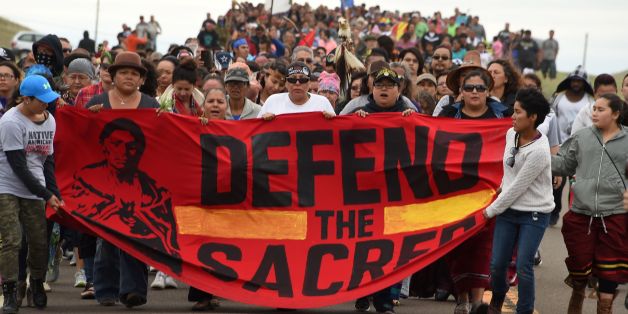
Native Americans march to the site of a sacred burial ground that was disturbed by bulldozers building the Dakota Access Pipeline (DAPL), near the encampment where hundreds of people have gathered to join the Standing Rock Sioux Tribe’s protest of the oil pipeline slated to cross the nearby Missouri River, September 4, 2016 near Cannon Ball, North Dakota.
Protestors were attacked by dogs and sprayed with an eye and respiratory irritant yesterday when they arrived at the site to protest after learning of the bulldozing work. / AFP / ROBYN BECK (Photo credit should read ROBYN BECK/AFP/Getty Images)
The Other Side from Advocates of the Pipeline:
1.CLAIM: The pipeline encroaches on indigenous lands.
TRUTH: The Dakota Access Pipeline traverses a path on private property and does not cross into the Standing Rock Sioux Tribe’s reservation. 100% of landowners in North Dakota voluntarily signed easements to allow for construction of the pipeline on their property. Nearly the entire route of the 1,172 mile pipeline has been sited and approved by relevant state and federal agencies and more than 22% of the pipeline has already been completed. To the extent possible, the Dakota Access Pipeline was routed to parallel existing infrastructure, such as the Northern Border Pipeline, to avoid environmentally sensitive areas and areas of potential cultural significance.”
ADDITIONAL COMMENTS Although land was taken from Sioux it was previously allocated to them in the Treaty of Fort Laramie. The pipeline itself comes within a mile of the reservation borders Unless the law since the treaty can be challenged. If this is some kind of border dispute, we need to return to renegotiating the treaty or make war.

I think other issues need to be discussed. First I would like to know more about the history of the Fort Laredo Treaty. Has it been observed? Are there competing tribal claims? Second, are all the people in this tribe in agreement? Have they voted on this issue? Third, is the claim of an ancestral burial lace valid and if so is there historical continuity even if the land is now off the reservations?
2. CLAIM: The pipeline exposes the Tribe’s water supply to contamination.
TRUTH: Pipelines are – by far – the safest way to transport energy liquids and gases. Already, 8 pipelines cross the Missouri River carrying hundreds of thousands of barrels of energy products every day. That includes the Northern Border natural gas pipeline – built in 1982 – that parallels the planned crossing for Dakota Access for 40 miles as well as high voltage transmission power lines. Once completed, the Dakota Access Pipeline will be among the safest, most technologically advanced pipelines in the world.
In addition, the Standing Rock Sioux Tribe’s water intake is scheduled to be moved by the end by of the year. The Missouri River intake serving the Tribe is being switched to Mobridge, South Dakota, nearly 50 miles south of the current water intake and about 70 miles south of the planned Dakota Access river crossing.
3. CLAIM: The tribal community was not part of the discussion.
TRUTH: 389 meetings took place between the U.S. Army Corps and 55 tribes about the Dakota Access project. In addition the Standing Rock Sioux Tribe met individually with the U.S. Army Corps nearly a dozen times to discuss archaeological and other surveys conducted to finalize the Dakota Access route.
In particular the Standing Rock Sioux tribe was offered ample time to consult with the U.S. Army Corps of Engineers, but refused, instead opting “to boycott the entire consulting process.” This petulance was again confirmed by the court’s review, which showed that, as the Army Corps of Engineers attempted more than a dozen times between 2014 and 2016 to discuss the DAPL route with the Standing Rock, “the tribe either failed to respond to requests for consultation or dragged its feet during the process.” It’s also noteworthy that the company building the pipeline – Energy Transfer Partners – had only originally moved the project near the Standing Rock reservation in the first place because doing so was considered “less impactful on the environment, according to the U.S. Army Corps of Engineers.”’
4. CLAIM: The pipeline is disrupting areas of cultural significance.
TRUTH: The Dakota Access Pipeline was routed to parallel existing infrastructure, such as the Northern Border Pipeline and high voltage transmission power lines. Designing the route to parallel existing infrastructure mitigates any additional impacts to the environment and avoids areas of potential cultural significance. On site there are professional archeologists who are able to identify and properly tend to artifacts and evidence of culturally significant sites if any not identified by the surveys are discovered.
I have not seen any objective statement for the basis of the claim that this is a tradtiona holy land for the Sioux. Tis is a difficult issue becaue the route s nto on Sioux land. The tribe needs to put forth some sort of record even if that is simply verbal;.
5. CLAIM: On site protests have been peaceful.
TRUTH: The trine has held formally to the non violent principles of Gandhi and King. However, non violence itself is a form of protests and is emotionally charged . Efforts by the police and army and the resistance by the protesters have led to endangered the safety of the workers, the protesters and non participant Sioux themselves. The work that is being done is in full accordance with all state and federal regulations and on private property – not on reservation land.
6. CLAIM: A young girl from the Tribe was mauled by a security dog.
TRUTH: This is a doctored photo. The original is from a June 2012 article from the New York Daily News.
7. CLAIM: The government is involved in massive effort to mine FACEBOOK ans other social media so as to soy on the protectors.
TRUTH: A deluge of wannabee heroes are posting false google maps locating themselves near the reservation.  They are doing this, supposedly, to confuse police agencies who use Facebook to see who is there. There is no evidence of an effort at anything like a government effort to infirnge on first amendment rights.
They are doing this, supposedly, to confuse police agencies who use Facebook to see who is there. There is no evidence of an effort at anything like a government effort to infirnge on first amendment rights.
People interested in the real issue might do a lot more good by contributing money or meeting with local native communities to show solidarity.
Why wasn’t the tribe answered properly when the notice first came out? Why wasn’t a full EIS done? Why, instead, was the “fast track” process used while the tribe was being ignored?
Why didn’t the tribe get a response when they responded to the notice for the project?
These are good questions. I wish the GD media would put some effort into answering them. I would esp like to see a history of the trety.
I do not know. However, I also have no way of knowing what is true and not true. The lack of real discussion is maddening.
Whoever wrote this article is a simple minded nitwit. You must be receiving some sort of kick back for writing this against the Native Americans. So many dense people we in this country. Sad.
I wrote it using reliable sources for facts. If you want to disagree, offer facts. You can do that in a reply or if you want to write something yourself, with good links, then we will post it.